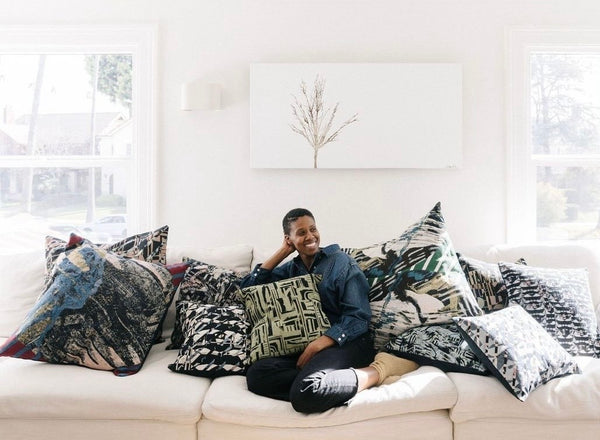Cart
Your cart is empty
K’era Morgan, a Los Angeles-based mixed-media painter and designer, has cultivated a deep appreciation for textile traditions from diverse cultures around the world. After founding a photographic-derived textile company, Morgan longed to return to the tactile process of creating by hand, setting the stage for her current artistic endeavors. Her mixed-media paintings reflect an intuitive approach, weaving together found fragments and mark-making to create non-linear narratives inspired by her surroundings and emotions.
In addition to her fine art practice, Morgan collaborates with American mills to translate her artwork into luxurious woven throw blankets, pillows, and tapestries for her brand, k-apostrophe. Launched in 2017, k-apostrophe embodies Morgan’s affinity for global textile surface design and the craft of quilt-making, offering a line of luxury prints and textiles for the home. With a focus on functionality and artistry, Morgan’s designs infuse everyday home decor with vibrant colors and bold patterns, inviting customers to elevate their living spaces with a touch of artful elegance.
Drawing from her background in textile design and her passion for the natural environment, Morgan’s work is characterized by bold color palettes and layered textures, reflecting the essence of her mood and emotions in each piece. Through k-apostrophe, Morgan seeks to celebrate global textile traditions while promoting sustainability and ethical production practices. From selecting natural fibers to collaborating with skilled artisans, the artist ensures that each k-apostrophe product reflects a commitment to quality craftsmanship and mindful consumption.
As k-apostrophe continues to grow, Morgan remains dedicated to her core principles of craftsmanship and sustainability, navigating the challenges of scaling the business while staying true to her vision. With a focus on authenticity and innovation, Morgan embraces the lessons learned from her entrepreneurial journey, recognizing that success often comes from taking risks and learning from mistakes. As she looks to the future, Morgan remains committed to creating artful yet everyday objects that inspire joy and connection in the home.
My Folklore spoke to K’era Morgan about turning her vibrant paintings into unique home décor, and why ethical craftsmanship is a key part of her brand

Your brand, k-apostrophe, blends contemporary design with heritage techniques. How did you decide on the specific craft traditions to bring into your collections?
I always consider a couple of factors when developing a new collection: what medium would best suit my vision of the end product as well as the design? And can it be done in a way that respects the chosen craft but is also feasible from a time and financial perspective?
As the brand has grown, there have been more opportunities to explore different techniques beyond woven textiles, which is what we launched with. Now, we have printed textile goods and have just added knitted blankets to the collection, which we are very excited about.
“Artful yet everyday” is your brand motto. Can you give a specific example of how you balance artistic concepts with the functionality of everyday home decor?
Our tabletop collection is a wonderful example of this idea. Most of what we do and encounter on a daily basis is often taken for granted and glossed over, so we become immune to these beautiful yet fleeting moments throughout our day. Art has a way of slowing us down, pulling us out of our auto-pilot mode and delivering a moment of pause… To breathe and possibly find gratitude before moving on to the next thing. The napkins and placemats are functional yet artful and can elevate a moment, mealtimes in this case, which I believe shouldn’t be rushed. When did nourishing your body become a chore or something we just had to rush through?
Clients often share that they save k-apostrophe table linens for special occasions, which is flattering to hear but my hope is that these linens are used and enjoyed regularly, and just maybe make your midday meal a little more sacred, for example.

Sustainability is woven into your brand’s DNA. What has been either a surprising success or unexpected challenge in making your products responsibly?
There hasn’t been a specific challenge as it relates to responsible production or the mindful approach the brand was built upon. It really comes down to not knowing any other way of doing business. It’s hard for me to fathom, in this day and age, not making business decisions that don’t account for the environment or the artisans that actually produce our various goods.
The hurdles that the brand has faced are those that I feel any small, creative company founded by a Black woman would come up against. If anything, it was about instilling a behavior change or connecting with customers who understand that good things take time. There is an immediacy factor that has been created with online shopping and most come to expect goods at their doorstep the day after purchase. That’s not k-apostrophe. Outside of what our retail partners have in stock, we make our products to order and I think our clients appreciate that the pillow they receive in the mail was woven, cut, and sewn for them.
The color stories within your pieces are both bold and calming. How do you approach color selection and what do you want it to evoke for the customer?
I am a painter first and foremost and all of my textile designs, including the color stories, are derived from my original works of art. That’s where it starts. I usually see something in a painting that sparks an idea that then starts off like, “I wonder what this would look like woven into a pillow cover…?” I have no fear or inhibitions when it comes to color. Combining colors and creating palettes is very intuitive to me and always has been. In the instances when I feel like I need to mix things up because I’m repeating the same combinations of shades or hues, I look to nature, which never fails me. My artwork is bold and layered and that is translated into my textiles. The collector and client that gravitate towards my work – whether it’s a painting or a throw blanket – are usually looking for something that is striking, something that is going to make a statement.


You mention a love of global textile traditions. Is there a specific motif or textural technique in your work that draws from a particular cultural heritage?
There are so many techniques I find fascinating when it comes to textiles and my brand hasn’t even scratched the surface of what is out there. I have a list of what I hope to try via collaborations with various artisans around the world. Some include wood block printing in India and woven ikats from Indonesia, for example. I did work with a collective for a while in Oaxaca on cushion covers made of 100% wool that was hand-spun, dyed and woven on looms that are traditionally used in that region of Mexico. But beyond infusing my brand with some of these heritage techniques, I’m inspired by the rich textile traditions that can be found throughout the globe. Devised for practical and ceremonial purposes, textiles are tactile artefacts that give insight into societal and cultural histories.
Luxurious yet accessible is a compelling proposition. Can you share your approach to sourcing your materials and why maintaining quality without exclusivity is important to you?
Luxury denotes quality, craftsmanship and longevity that is usually reserved for a select few because it involves great expense. Our approach usually consists of selecting natural fibers that have been minimally processed or recycled and artisan partners that are highly skilled at their craft and working within the parameters of what the technique dictates. This process ensures a well-made, long lasting product. These attributes, coupled with unique designs, is a true hallmark of luxury without all the extravagance. k-apostrophe is a testament that it can be done in a way that more people can partake in comfort and elegance regularly.

There’s an inviting, tactile feel to k-apostrophe products. How do you translate that online when a customer can’t physically experience the items?
That’s a good question and one my team and I ask ourselves every time we showcase a k-apostrophe item online via our website or on social media. Truth be told, a photograph will never ever replace the sense of touch but if done well and consistently, it can bring to life a mood. What we’ve come to learn is that creating a visual narrative with supporting language can provide a satisfying idea of what one can expect when unboxing a k-apostrophe product. In addition, sharing insight on the chosen material, how it’s made, and the inspiration behind the product gives the customer, or the viewer, trust that we are being truthful in what we are presenting.
Discover and shop k-apostrophe here

The Folklore is empowering brands to grow faster, save more, and sell globally through easy-to-use commerce, dropship, and shipping technology.
You Might Be Interested In:




Join our community
Discover the best products tailored for you.